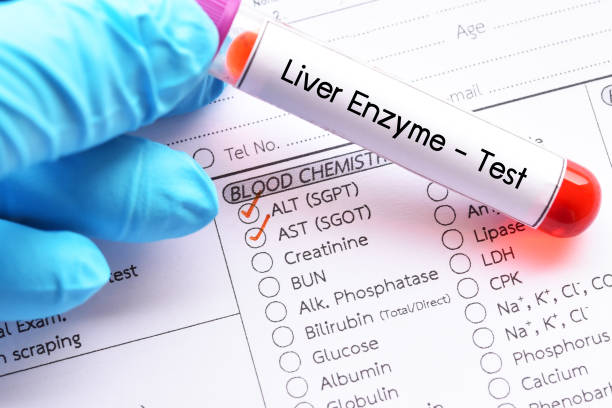The liver is one of the largest organs in the human body. It lies just below the diaphragm and to the right of the abdomen. The liver executes numerous functions that are critical for a healthy body. Ingested chemicals, drugs, and other substances are broken down into harmless or less toxic products by the liver.
Secondly, the liver is responsible for a host of synthetic functions. Liver cells synthesize enzymes, hormones, immune proteins, and clotting factors. The liver also serves as an excretory organ. It is responsible for the elimination of many metabolic waste products such as bilirubin.
As already mentioned, the liver secretes several enzymes, including:
- aspartate transaminase (AST),
- alanine transaminase (ALT),
- gamma-glutamyl transpeptidase(GGT),
- alkaline phosphatase(ALP)
These enzymes function mainly within the liver, but some are secreted into the bloodstream for transportation to other organs. Of note is that these enzymes are secreted by other organs such as the skeletal muscles, bones, and the heart.
Assessment of liver enzymes levels forms part of the routinely done liver function tests. Elevated liver enzymes is a cardinal feature of most liver diseases. Elevation of liver enzymes tends to be the first sign that occurs before the onset of symptoms. However, it is not cast on a stone that a person with elevated liver enzymes has liver disease. Sometimes it can be physiological, and in other instances, it can be due to conditions affecting other organs such as muscles or bone.
Depending on the disease process, an increase in liver enzymes may take one of three patterns. The hepatocellular pattern occurs when alanine aminotransferase and aspartate aminotransferase are increased. This pattern is caused by diseases or chemical insults that directly affect the liver cells. A cholestatic pattern is seen when either GGT or ALP is elevated. Such a pattern is seen in obstruction affecting bile flow either within the liver or the extra-hepatic bile ducts. A mixed pattern is seen when all the liver enzymes are increased.
Causes of increased aminotransferases(ALT/AST)
There are numerous causes of raised aminotransferases. Some of these disorders are discussed below.
Liver infections
Infectious hepatitis, either viral or bacterial, is a common cause of mildly elevated liver transaminases. Viral hepatitis is caused mainly by hepatitis A, B, C, D, or E viruses. It can also be caused by cytomegalovirus. Hepatitis B and C viruses are transmitted via sexual contact with an infected person, sharing of piercing instruments such as needles by intravenous drug users. Hepatitis A and E viruses are transmitted by the ingestion of contaminated foods or water.
Viral hepatitis can further be classified into acute viral hepatitis and chronic viral hepatitis. Acute viral hepatitis tends to take a varied course. The disease may be an asymptomatic, symptomatic yet self-limited disease, or a severe form that is known as a fulminant hepatic failure. In the majority of adults infected with either hepatitis A or B, the condition will be asymptomatic. The only sign is elevated liver enzymes. Infection with hepatitis C may either be asymptomatic or symptomatic.
The typical symptoms of acute viral hepatitis include generalized body weakness, loss of appetite, fatigue, fever, vomiting, yellow discoloration of the eyes (jaundice), dark urine, and upper abdominal pain and distension. Severe forms of acute viral hepatitis may progress to acute liver failure. Acute liver failure is characterized by the inability of the liver to synthesize clotting proteins.
Consequently, such individuals will have bleeding tendencies. Fulminant hepatitis is another form of severe acute viral hepatitis. It is characterized by the onset of mental status alteration (hepatic encephalopathy).
Hepatitis B and C viruses mainly cause chronic viral hepatitis. Progression of acute viral infection to chronic infection correlates with the age at infection. Those who get infected early in life (infancy) with the hepatitis B virus have a 90% probability of developing chronic disease. Hepatitis C infection progresses to chronic disease in 75%-85% of individuals, irrespective of the age at infection. Liver cirrhosis and subsequently, hepatocellular carcinoma may develop in a subset of individuals with chronic hepatitis C or B disease.
The symptoms of chronic viral hepatitis are similar to those of acute disease. Additionally, there is significant abdominal distension due to the development of portal hypertension. The skin becomes itchy (pruritus) due to the deposition of bile salts on the skin. Male patients may notice breast enlargements caused by excess estrogen.
The liver is responsible for estrogen metabolism. The stool changes color to pale. It can also be bloody or tar-colored due to bleeding from varices. Another common symptom is swelling in the ankles and legs (edema). This results from decreased oncotic pressure as the liver cannot produce adequate albumin and other proteins.
Treatment of Viral Hepatitis
The treatment of viral hepatitis depends on the causative virus. As a result, serologic studies must be done before initiation of therapy. For hepatitis caused by hepatitis A and E viruses, there is no definitive pharmacologic treatment. It is mainly supportive since it is a self-limiting disease.
However, severe vomiting warrants hospital admission. Such patients are at an increased risk of developing dehydration. Patients with acute liver failure require close monitoring. There is a need to prevent their progression to fulminant hepatic failure and hepatic encephalopathy.
For hepatitis caused by hepatitis B, there is no specific treatment for the acute disease. Supportive and symptomatic therapy is the mainstay. Lamivudine and tenofovir are some of the antivirals that can be used to alter the natural history of acute hepatitis B infection.
Treatment of chronic hepatitis B involves the use of drugs that inhibit the replication of the hepatitis B virus. In most instances, the treatment is lifelong, and discontinuation of therapy may be associated with relapse. Medications used include pegylated interferon and nucleoside/nucleotide analogs such as lamivudine. Proper treatment of chronic hepatitis B infection is associated with a decrease in the incidence of liver cancer and mortality.
Treatment of acute hepatitis C infection is rarely done. The reason being hepatitis C infection is seldom diagnosed early. However, if it is diagnosed in its critical stages, it is typically treated with pegylated interferon, which achieves viral suppression in most cases. Supportive treatment with fluids, analgesics, and antipyretics is also indicated.
Antiviral agents and interferon are the mainstay drugs in the treatment of chronic hepatitis C disease. The role of therapy is to hinder the progression of the disease, inhibit viral replication, and to reduce the development of cirrhosis. The drugs used in the treatment of chronic hepatitis C disease include interferon-alpha and ribavirin.
Alcohol-related Liver Injury/Alcoholic Hepatitis

Alcoholic hepatitis is a frequent cause of mildly increased liver enzymes. It causes elevated aminotransferases and gamma-glutamyl transferase. It is a disease entity characterized by progressive liver damage as a result of excessive long-term alcohol consumption. The cause of the damage is inflammatory. However, the exact mechanisms or pathogenesis is incompletely understood.
The symptoms of alcoholic hepatitis are usually straight forward. The patient usually has a history of excessive alcohol consumption over a long period. If that is not evident, clues to alcohol misuse that may be present in the past include previous convictions for intoxications, multiple car accidents due to drunk driving or poor social and interpersonal relationships.
The non-specific symptoms of alcoholic hepatitis include low-grade fever, fatigue, generalized weakness, loss of appetite, and nausea. These patients tend to have symptoms of impaired liver functions. These symptoms include a yellow discoloration of the eyes (jaundice), bleeding disorders, and frequent infections. There may also be abdominal distension and gastrointestinal bleeding due to portal hypertension.
On examination, the signs that can be elicited include jaundice and abdominal distension due to enlarged spleen and liver. The abdomen may also be distended due to ascites caused by portal hypertension. The patient may be confused and lethargic (hepatic encephalopathy). Other features of chronic liver disease that may be present in these patients include enlargement of breasts and alteration of hair distribution in males, peripheral edema, and prominent veins around the umbilicus (caput medusa).
The treatment of alcoholic hepatitis depends on the extent of liver injury. Luckily, in the vast majority of patients, the damage usually is mild. Such people require no specific treatment, and their prognosis is generally excellent. In fact, with discontinuation of alcohol consumption, the damage often reverses. In addition to stopping alcohol, the patient should take proper nutrition. Vitamins such as folate and thiamine should be supplemented. If the patient had developed a bleeding problem, they are given vitamin K. The alcohol withdrawal symptoms should be anticipated and treated accordingly.
Patients with acute severe alcoholic hepatitis are at increased risk of mortality. They should be managed as in-patients, preferably in ICU. Severe alcoholic hepatitis is treated with steroids such as prednisolone, which reduces liver inflammation. In instances where prednisolone is contraindicated, pentoxifylline is used. Other medications that may be used include acamprosate and naltrexone, both of which aid in alcohol cessation. When the condition has progressed to end-stage liver disease, liver transplantation is the only option.
Non-Alcoholic Fatty Liver Disease (NAFLD)
NAFLD, also known as non-alcoholic steatohepatitis, is the most frequent cause of increased liver enzymes. It is a spectrum of disease ranging from just steatosis, steatohepatitis to overt liver cirrhosis. NAFLD tends to occur in a background of insulin resistance, type 2 diabetes, hyperlipidemia, or obesity. Thus, it is a lifestyle disease.
NAFLD is usually a diagnosis of exclusion. The disorders in liver function tests are generally non-specific. Even though imaging studies using MRI or CT scans may show fatty infiltration of the liver, biopsy remains the single gold standard used to diagnose it.
NAFLD shares similar symptoms and signs with other liver disorders. The patient will have abdominal swelling caused by an enlarged liver (hepatomegaly) and ascites. In male patients, there will be changes in hair distribution and enlargement of breasts.
The palms tend to turn into a red color (palmer erythema). Yellowing of the eyes and skin is invariably present. Other common non-specific symptoms include abdominal pain, fatigue, and weight loss. These patients commonly have symptoms of other comorbid conditions.
Treatment of non-alcoholic fatty liver starts with lifestyle modification. These practices include physical exercise, intake of diets low in carbohydrates/fats, and weight loss. Pharmacologic treatment involves the use of antidiabetic drugs such as pioglitazone, exenatide, and liraglutide. Lipid-lowering drugs such as statins and aramchol are also indicated. To alleviate the oxidative stress associated with NAFLD, anti-oxidant medications such as pentoxifylline and vitamin E are used.
Toxins/Drugs-Related Liver Injury

Prescribed medications, OTC drugs, non-prescribed herbal medicines, and drugs of abuse may all cause an increase in liver enzymes. Depending on the dose, the levels of hepatic aminotransferases may be mild or severe elevated. Determination of the causative drug usually is difficult, especially in patients with multiple comorbidities that require several drugs.
The presentation of drug-induced liver injury is highly variable. The patient may be asymptomatic, with the elevation of liver enzymes being the only abnormality. If present, the symptoms are non-specific. They include vague abdominal pain, loss of appetite, nausea, vomiting, jaundice, abdominal and lower limb swelling, confusion, lethargy, and even coma.
There is no specific or definitive treatment for drug-induced hepatotoxicity. The treatment is mainly symptomatic and supportive. However, the first course of action is usually discontinuation of the offending drug. If the patient is on multiple medications, the replacement of one drug with a suitable alternative followed by checking the liver enzymes a few days later is the best course of action.
Some drugs have known antidotes. Acetaminophen-induced liver injury is treated with N-acetylcysteine, while a valproate-induced liver injury is treated with L-carnitine. If the pruritus/itchiness is severe, cholestyramine or ursodeoxycholic acid is indicated. For patients with drug-induced acute liver failure, liver transplantation is the best option.
Hemochromatosis
Hemochromatosis is a disease characterized by abnormal accumulation of iron in organs such as the liver, heart, and pancreas. It can be hereditary or secondary to another disease or therapeutic intervention, such as multiple blood transfusions.
It only becomes symptomatic when iron overload causes significant end-organ damage. Increased liver enzymes tend to be the first abnormality. As a result, male patients presenting with increased liver enzymes should always be screened for hereditary hemochromatosis.
The earliest symptoms of hemochromatosis include severe fatigue, joint pains, and impotence. Iron deposition in the skin causes hyperpigmentation and skin bronzing. Female patients develop amenorrhea, while in men, testicular damage leads to loss of libido and impotence. Symptoms present, which is suggestive of liver disease include abdominal pain and distension, yellowing of the skin and eyes, easy bruising, mental status alteration, and confusion.
Iron deposition in the heart and pancreas leads to their damage. Patients may present with symptoms of heart disease such as easy fatigue, exercise intolerance, and difficulty in breathing. They may also present with symptoms of diabetes, such as increased urinary frequency and excessive water intake due to pancreatic damage.
So long as target organ damage has not occurred, treatment of hemochromatosis is simple, safe, and inexpensive. It involves iron chelation using drugs such as Deferasirox(Exjade), dendrimers, deferoxamine, and deferiprone. The first-line treatment for hereditary hemochromatosis is regular phlebotomy (blood removal from a vein) to get rid of the excess iron.
Wilson’s disease
Wilson’s disease is a rare genetic disease that affects the liver, the brain, and other organs. The liver damage results in increased liver enzymes. The condition is due to a defect in copper metabolism with the body. This defect results in the deposition of copper in various organs such as the liver and brain.
Liver insults can manifest as chronic hepatitis, liver cirrhosis, or fulminant hepatic failure. Cirrhosis is the most frequent initial presentation. Wilson’s disease should always be suspected in patients younger than 40 years with unexplained chronic liver disease.
The symptoms and signs of Wilson’s disease are due to liver and brain involvement. The patient presents with abdominal distension and pain, vomiting of blood, yellowing of eyes and skin, and breast enlargement in males. Symptoms of brain involvement include personality changes, difficulty in speaking, excessive salivation, hand tremors, loss of balances, and seizures. The patients may also exhibit psychiatric symptoms such as self-injury, impulsive behavior, and emotional liability.
The treatment of Wilson’s disease involves the use of copper chelating agents such as penicillamine and trientine. This is the mainstay therapy, and it is lifelong. Symptomatic treatment involves the management of uncontrolled bleeding varices. This is done via either surgical decompression or transjugular intrahepatic shunting. Levodopa, baclofen, and anticholinergic are used to treat the symptoms of Parkinsonism and dystonia. Neuroleptics and anticonvulsants are indicated for the treatment of psychiatric symptoms and seizures, respectively.
Auto-Immune Hepatitis
Autoimmune hepatitis is a disease that predominantly affects young women(less than 40 years). The condition causes an increase in liver enzymes. The affected people commonly have other autoimmune disorders such as thyroiditis and systemic lupus. If not controlled, the inflammatory process eventually leads to cirrhosis or fulminant hepatic failure.
The symptoms of autoimmune hepatitis include fever, abdominal pain, jaundice, pruritus, loss of appetite, joint pains, easy bruising, fatigue, weight loss, skin rashes, edema, abdominal distension, and ascites. The signs that may be identified on physical examination include hepatomegaly, jaundice, splenomegaly, and spider angiomata.
Autoimmune hepatitis is treated with corticosteroids such as prednisolone. The corticosteroid may be used alone or in combination with azathioprine. Relapse tends to occur once treatment is discontinued. Liver transplantation is reserved for patients whose drug therapy has failed.
Causes of Increased Alkaline Phosphatase and GGT
ALP and GGT are the primary markers of cholestasis. These liver enzymes are increased when there is an obstruction to bile flow and in diseases such as primary biliary cirrhosis (PBC) and primary sclerosing cholangitis (PSC). Conditions affecting the bone also results in elevated ALP. The physiological elevation of ALP is seen in pregnancy and adolescents.
Symptoms suggestive of biliary obstruction, PBC, and PSC include vague abdominal pain, dark urine, pale (acholic) stool, severe itchiness, and jaundice. In the case of either PBC or PSC, the patients may have other autoimmune disorders such as autoimmune hepatitis, thyroiditis, or lupus.
Surgical intervention is the treatment of choice for biliary obstruction. Bile sequestrants such as cholestyramine can also be used. The pruritus is treated with antihistamines. Primary biliary cirrhosis or primary sclerosing cholangitis are treated with steroids, bile salt chelators, and other immunosuppressants. However, the diseases tend to progress to end-stage liver disease, which requires liver transplantation.
Causes of Increased Liver Enzymes during Pregnancy

Abnormal liver function tests are routinely encountered in the evaluation of a pregnant woman. Such a finding can either be physiological or pathologic. Pathologic increase in liver enzymes during pregnancy can be caused by obstetric disorders such as hyperemesis gravidarum, pre-eclampsia, eclampsia, HELLP syndrome, or acute fatty liver disease of pregnancy. It can also be caused by non-obstetric disorders such as viral hepatitis and autoimmunity.
The patient may be asymptomatic or may present with symptoms such as severe headache, visual disturbance, pain in the upper abdomen, or convulsions (pre-eclampsia and eclampsia). Those with hyperemesis gravidarum will have severe vomiting, poor weight gain or weight loss, and dehydration. Bleeding tendencies and symptoms of anemia, such as exercise intolerance and difficulty in breathing, are seen in the syndrome of hemolysis, elevated liver enzymes, and low platelets (HELLP syndrome).
The treatment of pre-eclampsia, HELLP syndrome, and eclampsia entails prompt delivery. The high blood pressure is treated with nifedipine, methyldopa, or labetalol. Magnesium sulfate is used to manage the convulsions.
Causes of Increased Liver Enzymes in the Pediatrics
The causes of increased liver enzymes in the pediatric age groups are diverse and tend to be age-dependent. In the neonatal period, the finding of elevated liver enzymes may be suggestive of conditions such as biliary atresia, neonatal sepsis, or idiopathic neonatal hepatitis. The main symptoms of these conditions are pale stools, yellow discoloration of the eyes and skin, poor weight gain, inability to feed, and irritability.
In older children and adolescents, the leading causes of increased liver enzymes are viral hepatitis and genetic liver diseases such as hereditary hemochromatosis. Drug overdose or intoxication is another cause common amongst adolescents. As a result, the healthcare provider should always try to elicit a history of exposure to hepatotoxic drugs such as acetaminophen, sulphonamides, or isoniazid.
Conclusion
Abnormal liver function test characterized by an increase in liver enzymes, a problem routinely encountered in the primary care setting. The causes of elevated liver enzymes are diverse and dependent on the age group and physiologic status. However, high liver enzymes do not necessarily imply the presence of disease. There are instances when the physiological process purely causes increased liver enzymes.
Furthermore, the cause of elevated liver enzymes is not always of hepatic origin. Some diseases affecting the bones, muscles, and heart may cause an increase in liver enzymes. The finding of increased liver enzymes calls for a thorough evaluation of the patient.
References
- https://www.ncbi.nlm.nih.gov/pmc/articles/PMC5719197/
- https://my.clevelandclinic.org/health/symptoms/17679-elevated-liver-enzymes
- https://emedicine.medscape.com/article/775507-overview
- https://www.mayoclinic.org/diseases-conditions/liver-problems/symptoms-causes/syc-20374502
- https://emedicine.medscape.com/article/170539-treatment#d11
- https://www.ncbi.nlm.nih.gov/pmc/articles/PMC5492893/
- https://emedicine.medscape.com/article/169814-overview#a9
- https://emedicine.medscape.com/article/177216-treatment#d11
- https://emedicine.medscape.com/article/183456-overview
- https://emedicine.medscape.com/article/172356-overview#a1
- https://www.ncbi.nlm.nih.gov/pmc/articles/PMC5016438/
- https://pedsinreview.aappublications.org/content/20/11/376


